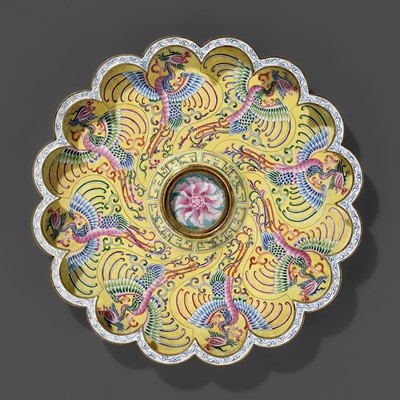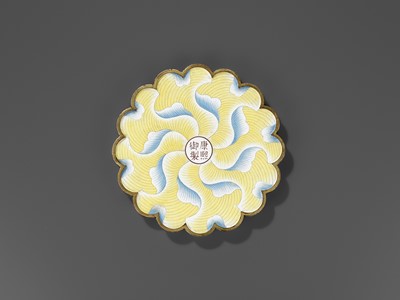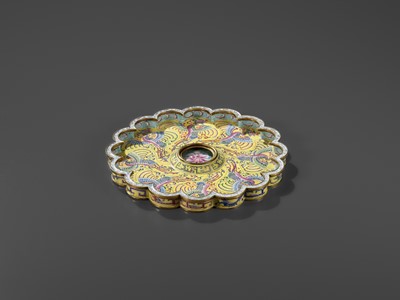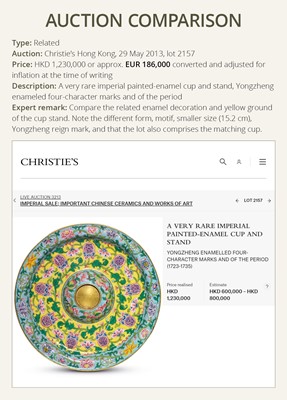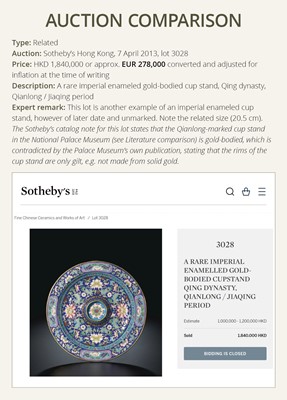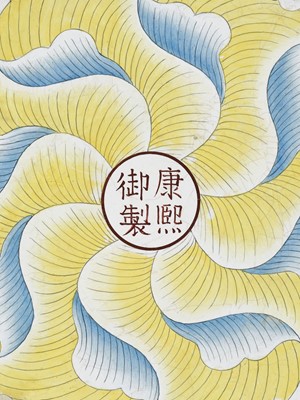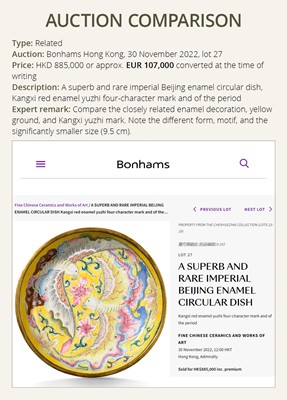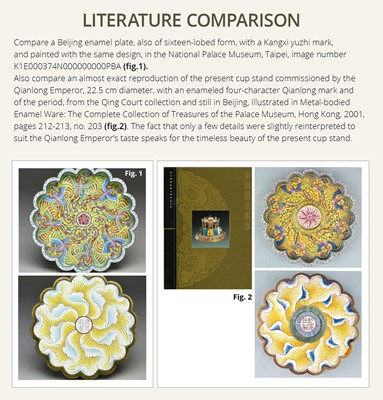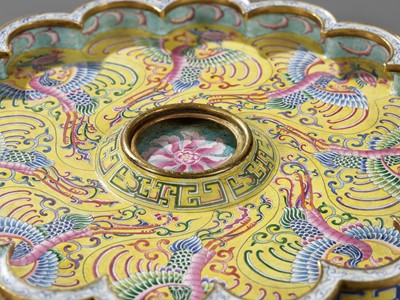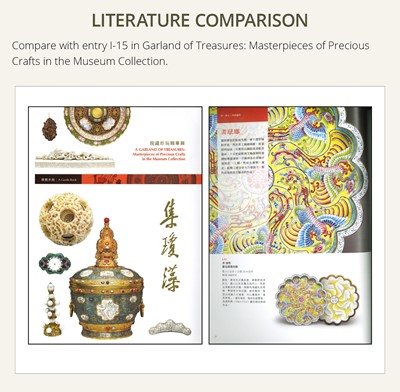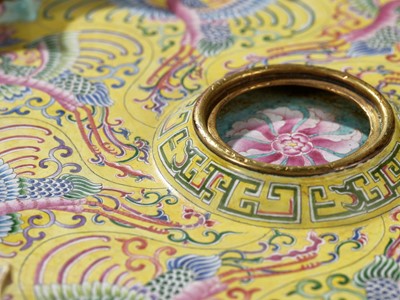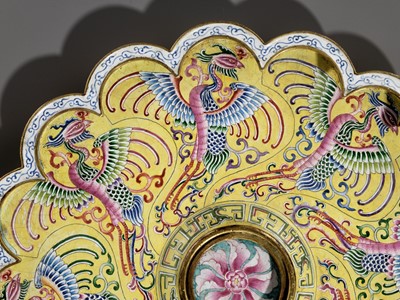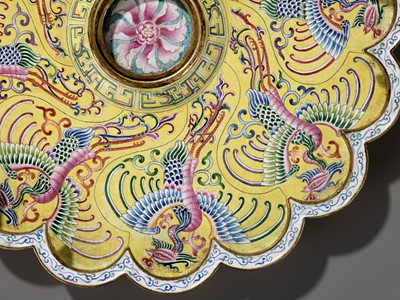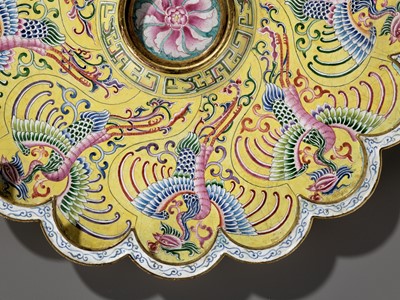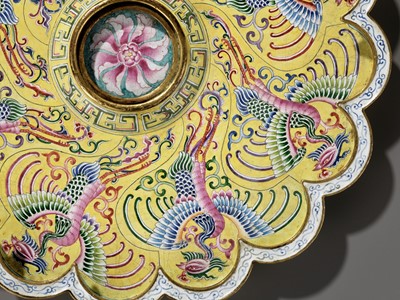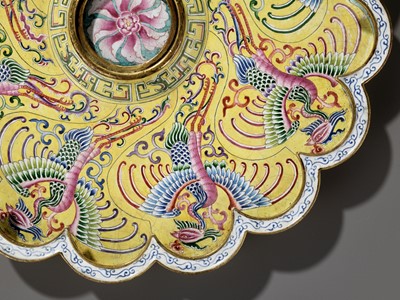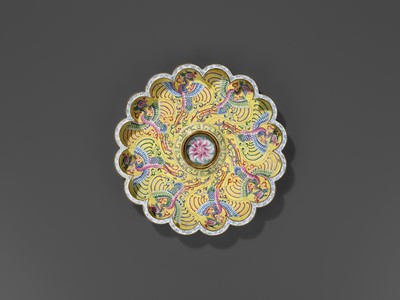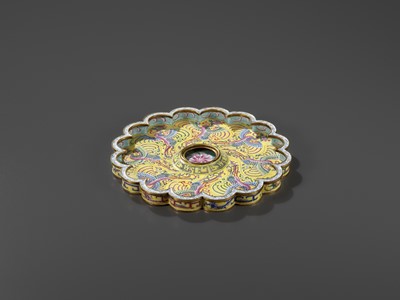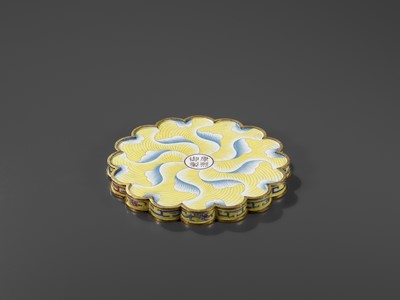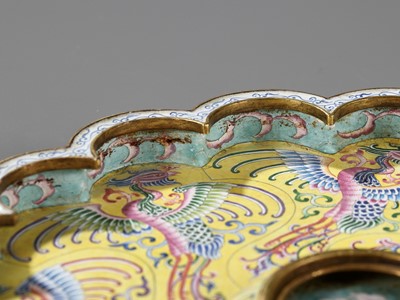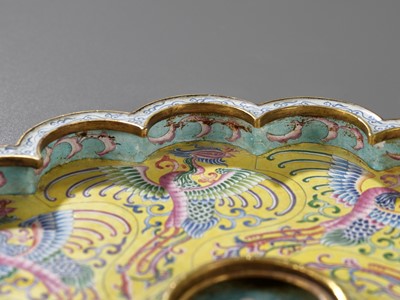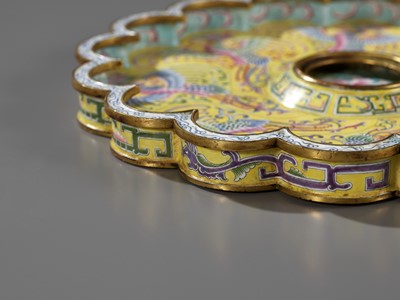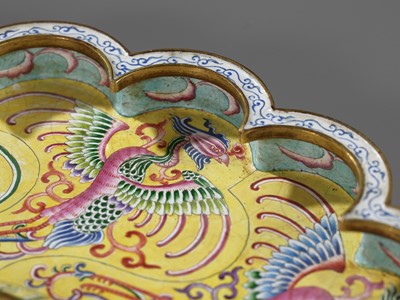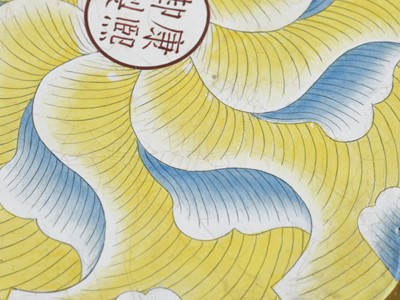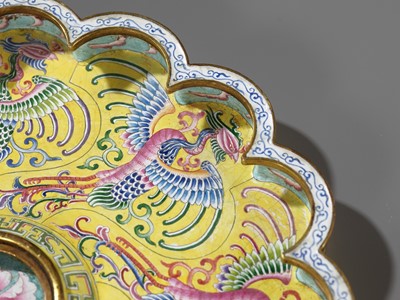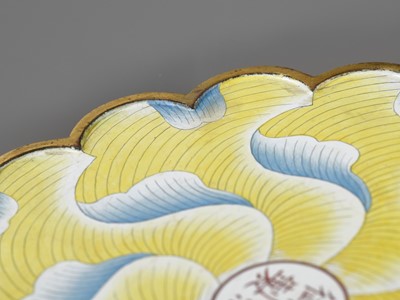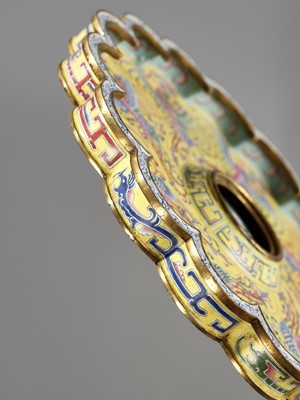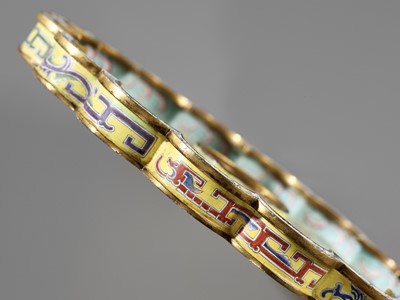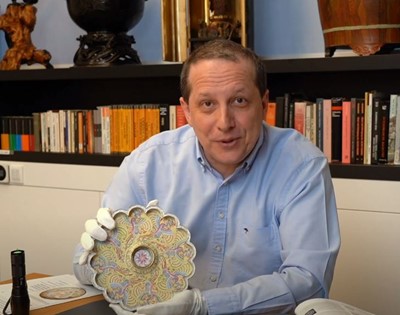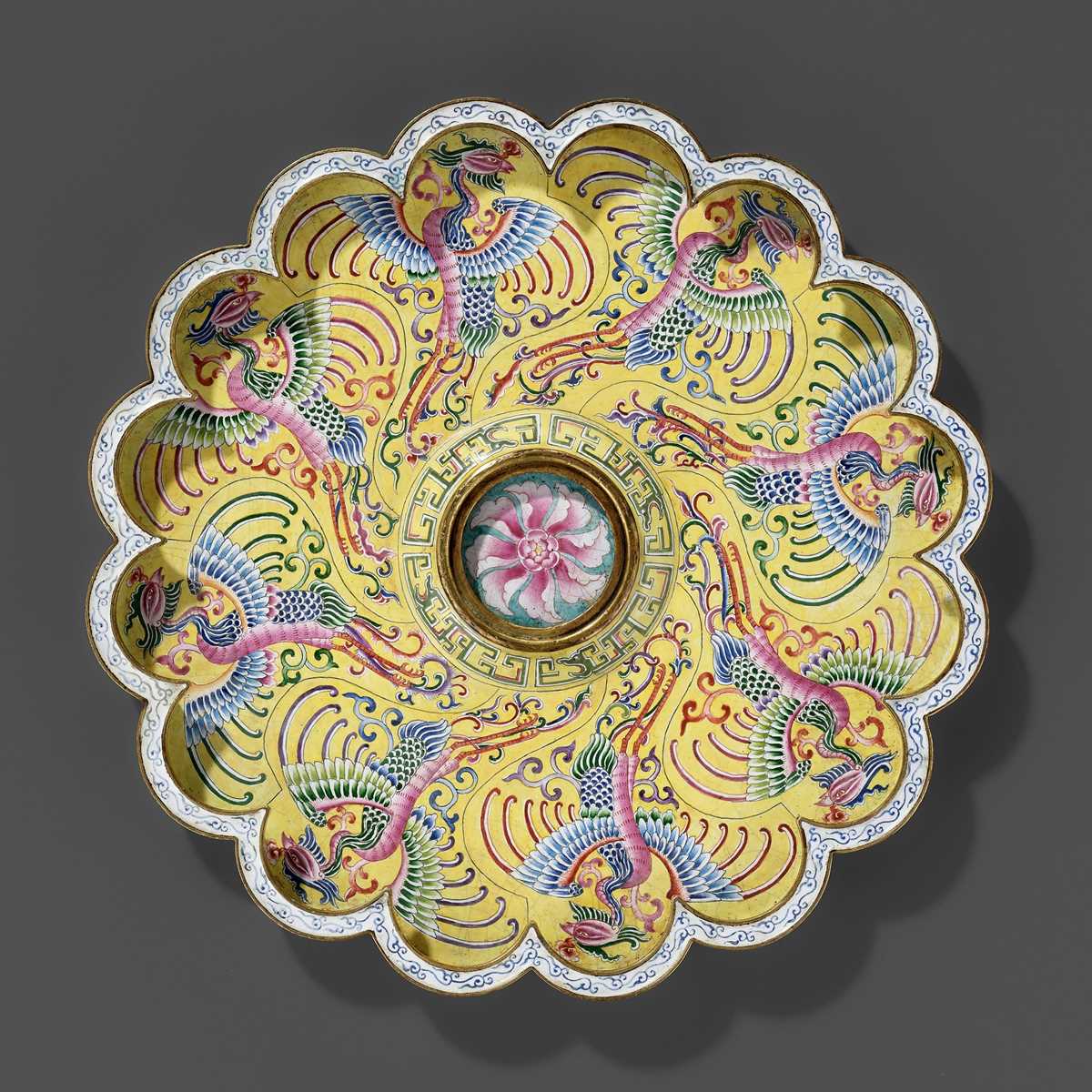9th Mar, 2023 13:00
TWO-DAY AUCTION - Fine Chinese Art / 中國藝術集珍 / Buddhism & Hinduism
12
AN IMPERIAL BEIJING ENAMEL CUP STAND, KANGXI YUZHI MARK AND OF THE PERIOD (1662–1722)
“康熙御製”款黃地花式鳳紋折沿杯托
Sold for €28,600
including Buyer's Premium
China, c. 1700-1722. Of sixteen-lobed form, the body of heavily cast copper alloy and with the rims finely gilt. Exquisitely painted in bright enamels, the interior with eight phoenixes radiating from the central raised stand with kuilong decoration against a yellow ground. The central recessed ring, added to support a cup, with a half-open peony bloom and furled petals against a turquoise ground, the base similarly painted with radiating and overlapping flower petals, centered by a roundel enclosing a red-enameled four-character mark Kangxi yuzhi and of the period.
Provenance: By repute from an old estate in London, United Kingdom. English trade, acquired from the above.
Condition: Good condition, commensurate with age, presenting remarkably well with crisp colors and a subtle luster overall. Old wear and a dense crackling to the enamels, as well as minor warping, dents and nicks to the metal fittings, exactly as expected from this type of ware. Small areas of verdigris, the inner edges and corners of the well with minor yet distinct areas of calcification, indicating the piece may have been used as a jardinière for some time. Obvious nicks and losses, no restoration or repair of any kind.
Weight: 744.3 g
Dimensions: Diameter 21.6 cm
The sides painted on the interior with petals against a turquoise ground and on the exterior with colorful kuilong against a yellow ground, the galleried rim with blue foliate scroll against a white ground.
The rich color palette and the delicacy of the multi-colored design employed to decorate this exquisite cup stand demonstrate the superb craftsmanship of the Imperial Palace Workshops in Beijing, the Zaobanchu, and the extraordinary skill of their painters. The technique of enameling on metal was originally introduced to the Chinese craftsmen in the Guangzhou area by French Jesuit missionaries in 1684, following the lifting of restrictions at Chinese ports. Being a port city, these artisans were the first to be exposed to wares from Europe and initially developed the skills to replicate these imports. Enamored with the range of vivid and pastel tones of both the imported and tributary wares, the Kangxi Emperor recruited enamel artisans from Guangzhou and Jesuit missionaries to work in the Palace and advance the proficiency of the Enamel Workshops. Painted enamel thus became a defining art form of this period, in quality, innovation, and unsurpassed opulence.
The appearance of Kangxi yuzhi marks – unframed, inside double circles, as in the case of the current cup stand – on a number of the surviving examples provides an indication of the Emperor’s close personal attachment to these pieces. This exquisitely decorated cup stand can probably be dated to the latter years of the Kangxi reign, possibly to the period AD 1700-22, since a fully developed enamel palette has been used to great effect in its painted decoration on a yellow ground, which is found on the majority of enameled metal vessels from this era. The delicately-painted phoenixes are rendered in both pink and blue enamels, of types which were not successfully prepared in the imperial ateliers until around 1700. In fact, this lot can be seen as a celebration of these newly invented enamel colors and the way they could be used to create painterly, but at the same time jewel-like, decoration. A related palette can be found on a small white-ground lobed box, also with a Kangxi yuzhi mark, in the collection of the National Palace Museum, Taipei (see Enamel Ware in the Ming and Qing Dynasties, Taipei, 1999, page 172, no. 82), which also bears a blue Kangxi yuzhi mark. The painting on the current lot is, however, executed with even greater sophistication.
Literature comparison:
Compare a Beijing enamel plate, also of sixteen-lobed form, with a Kangxi yuzhi mark, and painted with the same design, in the National Palace Museum, Taipei, image number K1E000374N000000000PBA.
Also compare an almost exact reproduction of the present cup stand commissioned by the Qianlong Emperor, 22.5 cm diameter, with an enameled four-character Qianlong mark and of the period, from the Qing Court collection and still in Beijing, illustrated in Metal-bodied Enamel Ware: The Complete Collection of Treasures of the Palace Museum, Hong Kong, 2001, pages 212-213, no. 203. The fact that only a few details were slightly reinterpreted to suit the Qianlong Emperor’s taste speaks for the timeless beauty of the present cup stand. Furthermore, compare with entry I-15 in Garland of Treasures: Masterpieces of Precious Crafts in the Museum Collection.
Auction result comparison:
Type: Related
Auction: Bonhams Hong Kong, 30 November 2022, lot 27
Price: HKD 885,000 or approx. EUR 107,000 converted at the time of writing
Description: A superb and rare imperial Beijing enamel circular dish, Kangxi red enamel yuzhi four-character mark and of the period
Expert remark: Compare the closely related enamel decoration, yellow ground, and Kangxi yuzhi mark. Note the different form, motif, and the significantly smaller size (9.5 cm).
Auction result comparison:
Type: Related
Auction: Christie’s Hong Kong, 29 May 2013, lot 2157
Price: HKD 1,230,000 or approx. EUR 186,000 converted and adjusted for inflation at the time of writing
Description: A very rare imperial painted-enamel cup and stand, Yongzheng enameled four-character marks and of the period
Expert remark: Compare the related enamel decoration and yellow ground of the cup stand. Note the different form, motif, smaller size (15.2 cm), Yongzheng reign mark, and that the lot also comprises the matching cup.
Auction result comparison:
Type: Related
Auction: Sotheby’s Hong Kong, 7 April 2013, lot 3028
Price: HKD 1,840,000 or approx. EUR 278,000 converted and adjusted for inflation at the time of writing
Description: A rare imperial enameled gold-bodied cup stand, Qing dynasty, Qianlong / Jiaqing period
Expert remark: This lot is another example of an imperial enameled cup stand, however of later date and unmarked. Note the related size (20.5 cm). The Sotheby’s catalog note for this lot states that the Qianlong-marked cup stand in the National Palace Museum (see Literature comparison) is gold-bodied, which is contradicted by the Palace Museum’s own publication, stating that the rims of the cup stand are only gilt, e.g. not made from solid gold.
“康熙御製”款黃地花式鳳紋折沿杯托
中國,約1700-1722年。銅胎琺瑯,盤沿繪白地藍彩卷草紋。盤心斜壁凸起,中心凹陷處以紅色團花,以團花爲中心,放射出波狀花瓣,每瓣內各繪一隻、共四對振翅欲飛的瑞鳳,循順時鐘方向舞動;盤心與花瓣皆鏨成淺浮雕,更增立體感。盤底與盤面呼應,白地上繪有八片葉片,以深色彩勾勒出葉形與葉脈、再以黃、藍色釉渲染。底心有白地“康熙御製”雙圓框雙行深紅色楷書。色澤明快,整體光澤細膩。
來源:據説來自英國倫敦私人收藏;英國古玩交易,購於上述收藏。
品相:品相完好,琺瑯有磨損和開片,胎體輕微翹曲、凹痕和刻痕。小面積包漿,內緣和角落有微小但明顯的鈣化區域,表明這件作品可能曾被用作花盆一段時間。明顯的劃痕和缺損。
重量:744.3 克
尺寸:直徑21.6 厘米
內矮盤壁繪藍地多色草葉紋,外壁繪與黃地多色盤夔龍紋。康熙朝畫琺瑯成熟期作品的特色之一,即是偏好以黃色為底,域外少見。本器器形、裝飾設計新穎,繪畫色階豐富、層次分明,釉料燒製勻淨光潔,為精美陳設器
琺瑯色彩鮮艷,異常精緻,彰顯了北京故宮造辦處的精湛技藝。1684年中國口岸解除限制後,法國耶穌會傳教士將銅胎琺瑯工藝傳授給廣州地區的中國工匠。作為一個港口城市,這些工匠最先接觸到來自歐洲的商品,並初步掌握了複製這些進口商品的技能。康熙皇帝被進口和進貢瓷器的各種生動和柔和的色調所吸引,從廣州招募了琺瑯工匠和耶穌會傳教士到皇宮工作。因此,琺瑯在品質、創新和無與倫比的奢華方面成為這一時期的標誌性藝術形式。
雙圈“康熙御製”款,無框,在許多現存的例子中的出現,表明了皇帝對这些作品的喜愛。這個裝飾精美的杯托可以追溯到康熙後期,可能是公元1700-1722年。精美彩繪的鳳凰以粉紅色和藍色琺瑯呈現,這些類型直到 1700 年左右才在皇家工坊中成功。事實上,這件拍品可以看作是對這些新發明的琺瑯顏色及其製作方式可以用來繪畫般的,但同時又有著寶石般晶瑩。台北故宮博物院所藏白地花瓣小盒,亦有“康熙御製”款,亦有類似的色彩(見明清琺瑯器,台北,1999年,第172頁,編號 82),還帶有藍色“康熙御製”款。然而,當前拍品上的繪畫更為複雜。
文獻比較:
比較一件康熙御製銅胎黃地十六瓣花式鳳紋折沿盤,有相同的設計,收藏於台北故宮博物院,台北,圖像編號K1E000374N000000000PBA。比較一件幾乎完全複製了乾隆皇帝委託的本杯架,直徑22.5 厘米,有乾隆四字款和年代,清廷收藏,還收藏於北京,《Metal-bodied Enamel Ware: The Complete Collection of Treasures of the Palace Museum》,香港,2001年,頁212-213,編號203。為迎合乾隆皇帝的品味,僅對少數細節進行了輕微的重新詮釋,說明了本杯架的永恆之美。此外還可以與《Garland of Treasures: Masterpieces of Precious Crafts in the Museum Collection》中編號I-15比較。
拍賣結果比較:
形制:相近
拍賣:香港邦瀚斯,2022年11月30日,lot 27
價格:HKD 885,000(相當於今日EUR 107,000)
描述:清康熙銅胎畫琺瑯黃地喜相逢小碟,紅彩「康熙御製」楷書款
專家評論:比較非常相近的琺瑯裝飾、黃地和康熙御製款。請注意不同的外形、主題和明顯尺寸(9.5 厘米)較小。
拍賣結果比較:
形制:相近
拍賣:香港佳士得,2013年5月29日,lot 2157
價格:HKD 1,230,000(相當於今日EUR 186,000)
描述:清雍正銅胎畫琺瑯黃地蓮壽紋盃連托,《雍正年製》楷書料款
專家評論:比較相近的琺瑯和黃地。請注意不同的外形、主題和尺寸(15.2 厘米)較小,雍正款及年代,此盤有一個相應的杯子。
拍賣結果比較:
形制:相近
拍賣:香港蘇富比,2013年4月7日,lot 3028
價格:HKD 1,840,000(相當於今日EUR 278,000)
描述:清乾隆 / 嘉慶御製金胎畫琺瑯「纏枝花卉」紋盞托
專家評論:此為另一件御製畫琺瑯盞托,但年代較晚且沒有款。請注意相近尺寸(20.5 厘米)。蘇富比拍賣圖錄標註蘇稱故宮博物院藏乾隆款杯座(見文獻比較)為金身,與故宮博物院稱杯座僅鍍金,不是純金製成的說法自刊相矛盾。
#byimperialcommand
#worksofart
China, c. 1700-1722. Of sixteen-lobed form, the body of heavily cast copper alloy and with the rims finely gilt. Exquisitely painted in bright enamels, the interior with eight phoenixes radiating from the central raised stand with kuilong decoration against a yellow ground. The central recessed ring, added to support a cup, with a half-open peony bloom and furled petals against a turquoise ground, the base similarly painted with radiating and overlapping flower petals, centered by a roundel enclosing a red-enameled four-character mark Kangxi yuzhi and of the period.
Provenance: By repute from an old estate in London, United Kingdom. English trade, acquired from the above.
Condition: Good condition, commensurate with age, presenting remarkably well with crisp colors and a subtle luster overall. Old wear and a dense crackling to the enamels, as well as minor warping, dents and nicks to the metal fittings, exactly as expected from this type of ware. Small areas of verdigris, the inner edges and corners of the well with minor yet distinct areas of calcification, indicating the piece may have been used as a jardinière for some time. Obvious nicks and losses, no restoration or repair of any kind.
Weight: 744.3 g
Dimensions: Diameter 21.6 cm
The sides painted on the interior with petals against a turquoise ground and on the exterior with colorful kuilong against a yellow ground, the galleried rim with blue foliate scroll against a white ground.
The rich color palette and the delicacy of the multi-colored design employed to decorate this exquisite cup stand demonstrate the superb craftsmanship of the Imperial Palace Workshops in Beijing, the Zaobanchu, and the extraordinary skill of their painters. The technique of enameling on metal was originally introduced to the Chinese craftsmen in the Guangzhou area by French Jesuit missionaries in 1684, following the lifting of restrictions at Chinese ports. Being a port city, these artisans were the first to be exposed to wares from Europe and initially developed the skills to replicate these imports. Enamored with the range of vivid and pastel tones of both the imported and tributary wares, the Kangxi Emperor recruited enamel artisans from Guangzhou and Jesuit missionaries to work in the Palace and advance the proficiency of the Enamel Workshops. Painted enamel thus became a defining art form of this period, in quality, innovation, and unsurpassed opulence.
The appearance of Kangxi yuzhi marks – unframed, inside double circles, as in the case of the current cup stand – on a number of the surviving examples provides an indication of the Emperor’s close personal attachment to these pieces. This exquisitely decorated cup stand can probably be dated to the latter years of the Kangxi reign, possibly to the period AD 1700-22, since a fully developed enamel palette has been used to great effect in its painted decoration on a yellow ground, which is found on the majority of enameled metal vessels from this era. The delicately-painted phoenixes are rendered in both pink and blue enamels, of types which were not successfully prepared in the imperial ateliers until around 1700. In fact, this lot can be seen as a celebration of these newly invented enamel colors and the way they could be used to create painterly, but at the same time jewel-like, decoration. A related palette can be found on a small white-ground lobed box, also with a Kangxi yuzhi mark, in the collection of the National Palace Museum, Taipei (see Enamel Ware in the Ming and Qing Dynasties, Taipei, 1999, page 172, no. 82), which also bears a blue Kangxi yuzhi mark. The painting on the current lot is, however, executed with even greater sophistication.
Literature comparison:
Compare a Beijing enamel plate, also of sixteen-lobed form, with a Kangxi yuzhi mark, and painted with the same design, in the National Palace Museum, Taipei, image number K1E000374N000000000PBA.
Also compare an almost exact reproduction of the present cup stand commissioned by the Qianlong Emperor, 22.5 cm diameter, with an enameled four-character Qianlong mark and of the period, from the Qing Court collection and still in Beijing, illustrated in Metal-bodied Enamel Ware: The Complete Collection of Treasures of the Palace Museum, Hong Kong, 2001, pages 212-213, no. 203. The fact that only a few details were slightly reinterpreted to suit the Qianlong Emperor’s taste speaks for the timeless beauty of the present cup stand. Furthermore, compare with entry I-15 in Garland of Treasures: Masterpieces of Precious Crafts in the Museum Collection.
Auction result comparison:
Type: Related
Auction: Bonhams Hong Kong, 30 November 2022, lot 27
Price: HKD 885,000 or approx. EUR 107,000 converted at the time of writing
Description: A superb and rare imperial Beijing enamel circular dish, Kangxi red enamel yuzhi four-character mark and of the period
Expert remark: Compare the closely related enamel decoration, yellow ground, and Kangxi yuzhi mark. Note the different form, motif, and the significantly smaller size (9.5 cm).
Auction result comparison:
Type: Related
Auction: Christie’s Hong Kong, 29 May 2013, lot 2157
Price: HKD 1,230,000 or approx. EUR 186,000 converted and adjusted for inflation at the time of writing
Description: A very rare imperial painted-enamel cup and stand, Yongzheng enameled four-character marks and of the period
Expert remark: Compare the related enamel decoration and yellow ground of the cup stand. Note the different form, motif, smaller size (15.2 cm), Yongzheng reign mark, and that the lot also comprises the matching cup.
Auction result comparison:
Type: Related
Auction: Sotheby’s Hong Kong, 7 April 2013, lot 3028
Price: HKD 1,840,000 or approx. EUR 278,000 converted and adjusted for inflation at the time of writing
Description: A rare imperial enameled gold-bodied cup stand, Qing dynasty, Qianlong / Jiaqing period
Expert remark: This lot is another example of an imperial enameled cup stand, however of later date and unmarked. Note the related size (20.5 cm). The Sotheby’s catalog note for this lot states that the Qianlong-marked cup stand in the National Palace Museum (see Literature comparison) is gold-bodied, which is contradicted by the Palace Museum’s own publication, stating that the rims of the cup stand are only gilt, e.g. not made from solid gold.
“康熙御製”款黃地花式鳳紋折沿杯托
中國,約1700-1722年。銅胎琺瑯,盤沿繪白地藍彩卷草紋。盤心斜壁凸起,中心凹陷處以紅色團花,以團花爲中心,放射出波狀花瓣,每瓣內各繪一隻、共四對振翅欲飛的瑞鳳,循順時鐘方向舞動;盤心與花瓣皆鏨成淺浮雕,更增立體感。盤底與盤面呼應,白地上繪有八片葉片,以深色彩勾勒出葉形與葉脈、再以黃、藍色釉渲染。底心有白地“康熙御製”雙圓框雙行深紅色楷書。色澤明快,整體光澤細膩。
來源:據説來自英國倫敦私人收藏;英國古玩交易,購於上述收藏。
品相:品相完好,琺瑯有磨損和開片,胎體輕微翹曲、凹痕和刻痕。小面積包漿,內緣和角落有微小但明顯的鈣化區域,表明這件作品可能曾被用作花盆一段時間。明顯的劃痕和缺損。
重量:744.3 克
尺寸:直徑21.6 厘米
內矮盤壁繪藍地多色草葉紋,外壁繪與黃地多色盤夔龍紋。康熙朝畫琺瑯成熟期作品的特色之一,即是偏好以黃色為底,域外少見。本器器形、裝飾設計新穎,繪畫色階豐富、層次分明,釉料燒製勻淨光潔,為精美陳設器
琺瑯色彩鮮艷,異常精緻,彰顯了北京故宮造辦處的精湛技藝。1684年中國口岸解除限制後,法國耶穌會傳教士將銅胎琺瑯工藝傳授給廣州地區的中國工匠。作為一個港口城市,這些工匠最先接觸到來自歐洲的商品,並初步掌握了複製這些進口商品的技能。康熙皇帝被進口和進貢瓷器的各種生動和柔和的色調所吸引,從廣州招募了琺瑯工匠和耶穌會傳教士到皇宮工作。因此,琺瑯在品質、創新和無與倫比的奢華方面成為這一時期的標誌性藝術形式。
雙圈“康熙御製”款,無框,在許多現存的例子中的出現,表明了皇帝對这些作品的喜愛。這個裝飾精美的杯托可以追溯到康熙後期,可能是公元1700-1722年。精美彩繪的鳳凰以粉紅色和藍色琺瑯呈現,這些類型直到 1700 年左右才在皇家工坊中成功。事實上,這件拍品可以看作是對這些新發明的琺瑯顏色及其製作方式可以用來繪畫般的,但同時又有著寶石般晶瑩。台北故宮博物院所藏白地花瓣小盒,亦有“康熙御製”款,亦有類似的色彩(見明清琺瑯器,台北,1999年,第172頁,編號 82),還帶有藍色“康熙御製”款。然而,當前拍品上的繪畫更為複雜。
文獻比較:
比較一件康熙御製銅胎黃地十六瓣花式鳳紋折沿盤,有相同的設計,收藏於台北故宮博物院,台北,圖像編號K1E000374N000000000PBA。比較一件幾乎完全複製了乾隆皇帝委託的本杯架,直徑22.5 厘米,有乾隆四字款和年代,清廷收藏,還收藏於北京,《Metal-bodied Enamel Ware: The Complete Collection of Treasures of the Palace Museum》,香港,2001年,頁212-213,編號203。為迎合乾隆皇帝的品味,僅對少數細節進行了輕微的重新詮釋,說明了本杯架的永恆之美。此外還可以與《Garland of Treasures: Masterpieces of Precious Crafts in the Museum Collection》中編號I-15比較。
拍賣結果比較:
形制:相近
拍賣:香港邦瀚斯,2022年11月30日,lot 27
價格:HKD 885,000(相當於今日EUR 107,000)
描述:清康熙銅胎畫琺瑯黃地喜相逢小碟,紅彩「康熙御製」楷書款
專家評論:比較非常相近的琺瑯裝飾、黃地和康熙御製款。請注意不同的外形、主題和明顯尺寸(9.5 厘米)較小。
拍賣結果比較:
形制:相近
拍賣:香港佳士得,2013年5月29日,lot 2157
價格:HKD 1,230,000(相當於今日EUR 186,000)
描述:清雍正銅胎畫琺瑯黃地蓮壽紋盃連托,《雍正年製》楷書料款
專家評論:比較相近的琺瑯和黃地。請注意不同的外形、主題和尺寸(15.2 厘米)較小,雍正款及年代,此盤有一個相應的杯子。
拍賣結果比較:
形制:相近
拍賣:香港蘇富比,2013年4月7日,lot 3028
價格:HKD 1,840,000(相當於今日EUR 278,000)
描述:清乾隆 / 嘉慶御製金胎畫琺瑯「纏枝花卉」紋盞托
專家評論:此為另一件御製畫琺瑯盞托,但年代較晚且沒有款。請注意相近尺寸(20.5 厘米)。蘇富比拍賣圖錄標註蘇稱故宮博物院藏乾隆款杯座(見文獻比較)為金身,與故宮博物院稱杯座僅鍍金,不是純金製成的說法自刊相矛盾。
#byimperialcommand
#worksofart
Zacke Live Online Bidding
Our online bidding platform makes it easier than ever to bid in our auctions! When you bid through our website, you can take advantage of our premium buyer's terms without incurring any additional online bidding surcharges.
To bid live online, you'll need to create an online account. Once your account is created and your identity is verified, you can register to bid in an auction up to 12 hours before the auction begins.
Intended Spend and Bid Limits
When you register to bid in an online auction, you will need to share your intended maximum spending budget for the auction. We will then review your intended spend and set a bid limit for you. Once you have pre-registered for a live online auction, you can see your intended spend and bid limit by going to 'Account Settings' and clicking on 'Live Bidding Registrations'.
Your bid limit will be the maximum amount you can bid during the auction. Your bid limit is for the hammer price and is not affected by the buyer’s premium and VAT. For example, if you have a bid limit of €1,000 and place two winning bids for €300 and €200, then you will only be able to bid €500 for the rest of the auction. If you try to place a bid that is higher than €500, you will not be able to do so.
Online Absentee and Telephone Bids
You can now leave absentee and telephone bids on our website!
Absentee Bidding
Once you've created an account and your identity is verified, you can leave your absentee bid directly on the lot page. We will contact you when your bids have been confirmed.
Telephone Bidding
Once you've created an account and your identity is verified, you can leave telephone bids online. We will contact you when your bids have been confirmed.
Classic Absentee and Telephone Bidding Form
You can still submit absentee and telephone bids by email or fax if you prefer. Simply fill out the Absentee Bidding/Telephone bidding form and return it to us by email at office@zacke.at or by fax at +43 (1) 532 04 52 20. You can download the PDF from our Upcoming Auctions page.
How-To Guides
How to Create Your Personal Zacke Account
How to Register to Bid on Zacke Live
How to Leave Absentee Bids Online
How to Leave Telephone Bids Online
中文版本的操作指南
创建新账号
注册Zacke Live在线直播竞拍(免平台费)
缺席投标和电话投标
Third-Party Bidding
We partner with best-in-class third-party partners to make it easy for you to bid online in the channel of your choice. Please note that if you bid with one of our third-party online partners, then there will be a live bidding surcharge on top of your final purchase price. You can find all of our fees here. Here's a full list of our third-party partners:
- 51 Bid Live
- EpaiLive
- ArtFoxLive
- Invaluable
- LiveAuctioneers
- the-saleroom
- lot-tissimo
- Drouot
Please note that we place different auctions on different platforms. For example, in general, we only place Chinese art auctions on 51 Bid Live.
Bidding in Person
You must register to bid in person and will be assigned a paddle at the auction. Please contact us at office@zacke.at or +43 (1) 532 04 52 for the latest local health and safety guidelines.
